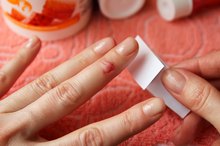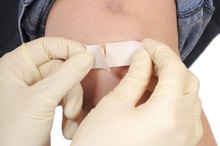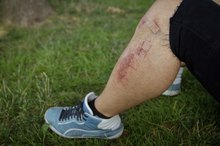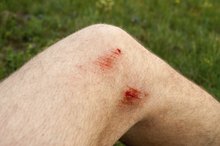What does fact checked mean?
At Healthfully, we strive to deliver objective content that is accurate and up-to-date. Our team periodically reviews articles in order to ensure content quality. The sources cited below consist of evidence from peer-reviewed journals, prominent medical organizations, academic associations, and government data.
The information contained on this site is for informational purposes only, and should not be used as a substitute for the advice of a professional health care provider. Please check with the appropriate physician regarding health questions and concerns. Although we strive to deliver accurate and up-to-date information, no guarantee to that effect is made.
How to Treat a Weeping Wound
When treating a wound it is important to note that there is a difference between an affected area that is weeping blood, and an area that is weeping pus. Bleeding is a natural way for the body to clean out bacteria from the wound by expelling it, whereas discharge or pus can often mean that the wound is infected. This can appear as a pink, yellow or yellow-green fluid. Pus weeping from a septic wound can also be quite foul-smelling. It is important to treat the wound correctly to clear infection and to allow the wound to heal.
Stop the wound from weeping blood by keeping the infected area raised. Small cuts and grazes will quickly stop bleeding on their own 2. Apply gentle pressure to a more serious wound using a clean cloth. After 30 minutes of constant pressure, the wound should have stopped bleeding. If the wound continues to bleed, seek medical assistance immediately.
How to Make Cuts Heal Faster
Learn More
Clean the wound with clear water or saline solution. Do not use soap, as this can irritate the wound. Alcohol can also be used to clean a wound in an emergency. Extract any remaining dirt or fragments of debris using tweezers. If you are unable to completely clean the wound, you must seek medical help as soon as possible. It is vital to clean the wound thoroughly to prevent infection. Once the wound has been cleaned, apply an ointment to keep the area moist such as Neosporin.
Ensure that the skin around the wound comes together to allow it to heal. Cuts that measure two inches or less can be closed using adhesive strips, whereas longer cuts or cuts that are more than a quarter of an inch deep will need stitches to close. It is important to get the wound closed as soon as possible to prevent harmful bacteria getting inside and causing an infection. Keep the wound covered using bandages. The dressing should be changed and the wound cleaned daily or more often if it becomes dirty.
How to Lance a Wound
Learn More
Look for signs of infection when changing the wound dressing. If the wound is weeping pus, this must be cleaned out of the wound using water or saline solution. Swelling, redness and increased pain are also indications of infection. Seek medical assistance if your wound continues to weep pus or appears infected in any way. You will need a course of prescribed antibiotics, as well as a tetanus shot to clear the infection and to prevent it from spreading.
Related Articles
References
- Mayo Clinic: Cuts And Scrapes
- NHS: Cuts And Grazes
- Mccaughan D, Sheard L, Cullum N, Dumville J, Chetter I. Patients' perceptions and experiences of living with a surgical wound healing by secondary intention: A qualitative study. Int J Nurs Stud. 2018;77:29-38. doi:10.1016/j.ijnurstu.2017.09.015
- Krafts KP. Tissue repair: The hidden drama. Organogenesis. 2010;6(4):225-33. doi:10.4161/org.6.4.12555
- Chetter IC, Oswald AV, Fletcher M, Dumville JC, Cullum NA. A survey of patients with surgical wounds healing by secondary intention; an assessment of prevalence, aetiology, duration and management. J Tissue Viability. 2017;26(2):103-107. doi:10.1016/j.jtv.2016.12.004
- Singh PK, Saxena N, Poddar D, et al. Comparative Study Of Wound Healing In Primary Versus Delayed Primary Closure In Contaminated Abdominal Surgery. Hellenic J Surg. 2016;88:314–320. doi:10.1007/s13126-016-0340-8
- Surgical Patient Education Program: Prepare for the Best Recovery. American College of Surgeons. 2018.
- Rushbrook JL, White G, Kidger L, Marsh P, Taggart TF. The antibacterial effect of 2-octyl cyanoacrylate (Dermabond®) skin adhesive. J Infect Prev. 2014;15(6):236-239. doi:10.1177/1757177414551562
- Lazar HL, Mccann J, Fitzgerald CA, Cabral HJ. Adhesive strips versus subcuticular suture for mediansternotomy wound closure. J Card Surg. 2011;26(4):344-7. doi:10.1111/j.1540-8191.2011.01257.x
- 3M Wound Resource Center. http://solutions.3m.co.uk/wps/portal/3M/en_GB/skin-care/wound-resource-centre/








